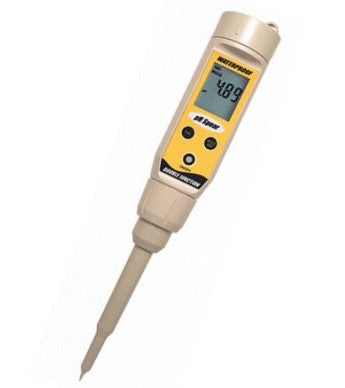Maintaining healthy soil is the key to growing a healthy and productive plant. Soil pH is a vital component of ensuring your soil provides a favourable root medium for the type of plants you grow. This means that measuring soil pH is essential for anyone who’s serious about horticulture, from professional horticulturalists to keen home gardeners.
This article provides some insight into the technology that makes soil pH testers function and the different methods you can use with a pH meter to test your soil.
About Soil pH
The pH range is a measure of acidity or alkalinity of a substance. pH follows a logarithmic scale from 0 to 14 with 0 being acidic, 7 being neutral and 14 being alkaline.
For most plants, the ideal pH conditions will fall between pH 5.5 and 7.5, but ranges vary between species, so be sure to check the ideal range of the specific plants you wish to grow. See our article The 5 Best Digital Soil pH Testers for the ideal soil pH ranges for some common vegetable, fruit and ornamental plants.
Methods of testing soil pH
In summary, there are two main methods exploited by soil pH testers:
- Direct ground measurement – This is where soil pH is sampled using an electrode that’s placed directly in the ground. This method is terrific for nursery and field testing but care is needed to ensure you don’t damage your tester’s electrode. Where the soil you wish to test is firm to hard, it’s recommended that you first use an auger to disrupt the soil and then dampen the soil using distilled water before taking your measurements.
- Soil slurry or dilution method – This technique is slightly more time consuming but less damaging to the electrode probe.It involves mixing your soil with distilled water in a container before using your pH tester take a measurement.
For a comprehensive, step-by-step explanation of both the sampling procedures mentioned above see our article How to use a soil pH meter.
How a soil pH tester works
Portable Soil pH testers will have one of two main designs. They will either incorporate an electrode in the body of the device (all-in-one design), or the electrode will be connected to the main body by a wire.

Irrespective of the design, the principle behind the technology is the same. The pH electrode that takes the pH measurement consists internally of a reference electrode, reference solution, reference junction and a glass bulb with a hydrated gel layer. When your electrode is submerged in the diluted sample or pressed into the soil an electrical current is triggered. The tester then calculates the charge of the reference solution inside the bulb and compares it to the soil medium outside of the gel layer. This comparison results in a pH measurement which is displayed on the pH meter’s screen – all within a matter of seconds.
Examples of soil pH testers
With an overview of how soil pH meters work and the different methods of testing soil pH, you realise that the variations in soil tester design are essentially about matching features to your application. Do you need a large display, a more robust electrode, should your device be waterproof, what sampling rate do you require, and so on. To give you an idea, the Scientists at Instrument Choice have selected some representative examples of soil pH testers.
Spear Tip Waterproof pH Tester 
This model is designed for one-handed use and with a simple to maintain pH spear. Results are displayed on a large, easy to read digital display screen.
Suitable for: Professional, commercial and home gardener use. Suitable for both Direct ground measurement and dilution method.
GroLine Soil pH Tester 
The HI981030 is jam-packed with advanced features. The large-sized LCD provides at a glance results from almost any angle.
Suitable for: Home and commercial operations, for both Direct ground measurement and dilution method.
Soil pH Meter with Separate Electrode 
This soil pH meter comes with a cabled spear tip electrode for easy soil penetration and a fast sampling rate, displaying results on the LCD screen in 0.8 seconds.
Suitable for: Commercial operations, for both direct ground measurement and dilution method.
Direct Soil pH Measurement Kit 
A dedicated soil pH measurement tester, the HI99121 comes complete with a multilevel LCD display and spear tipped electrode. The meter is compact, heavy-duty and waterproof to withstand work out in the field.
Suitable for: Professional use, direct ground measurement and dilution method.
Conclusion
Although the inner workings are complex, pH soil testers make determining the pH of your soil easy. Through one of the two methods of soil sampling, accurate soil pH measurements can be obtained in seconds.
Want more information on How soil pH testers work? Need help determining the best method for sampling soil? Contact one of the Instrument Choice Scientists. We’re here to help!
Call 1300 737 871 for a chat or email customer-service@instrumentchoice.com.au and receive a response within three business hours.
